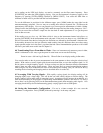7
3. SIGNAL CONNECTIONS
3.1 General - In this section I’ll describe how to connect a HP3586 for measuring frequency and power
level in the selective modes. In the following chapters I’ll also describe any differences for other
measurement modes.
3.2 Signal Input and Termination – Never put more than +27dbm or .5 watts total power into the
input 50 or 75 ohm connector of a HP3586 when using the internal termination. Never put more
than an AC + DC total of +42 volts into an unterminated connector.
To get a signal into a HP3586 you have the choice of many different input connectors and impedances.
However the only input I’ve found useful is the 75 or 50 ohm unbalanced input. All other inputs,
including the 600 ohm one, are not useful over the complete frequency range of the HP3586 and terminate
in impedances usually used for telephone circuits but not for RF circuits. The 75 or 50 ohm input is usable
over the instruments complete frequency range. Those with a HP3586C are fortunate that it has a 50 ohms
input. A or B versions only have a 75 ohm input. Most of the surplus instruments have telephone type
input connectors but many of us have converted ours to a more standard BNC connector for radio use. The
A and B version make all their power calculations based on 75 ohms even if the input is unterminated or
has an external 50 ohm termination resistor. However you can enter an offset to compensate for this
difference, more on this in section 6.2 of Chapter 6.
When making on the air measurements to a 50 ohm unterminated antenna line, use the 50 ohm termination
option on a C version or use a 50 ohm terminating resistor on the A and B versions and use the 10K 50pf
unterminated 75 ohm input. When measuring antenna signals in parallel with a receiver having a
terminated 50 ohm input, just simply hook a short 50 ohm feed line to the receiver’s antenna terminal in
parallel with the receivers antenna input and use the unterminated input option on all models of the HP-
3586.
When making measurements on RF circuits you can terminate the input with 50 or 75 ohms termination,
but on many circuits you may want to use the higher 10K 50pf unterminated input. Unfortunately this is
not very high for some tuned circuits and the 50pf may detune the circuit causing measurement errors. HP
did at one time offer accessory probes to isolate these circuits however they are not easy to obtain today so
consider a link coupling if only measuring frequency. For accurate level measurements you may want to
consider building a FET source follower or tube cathode follower one to one isolation amplifier to isolate
these circuits from the instrument’s input. I’ve shown two suggested circuits for this in Appendix C.
3.3 Tracking Oscillator’s Output Signal - This output signal can drive a transmitter or other device,
connect a BNC male connector with a 75 ohm line from the driven device’s input to the Fo output
connector located on the back panel. This outputs power is 0dbm or .27 volts RMS, which may not drive
many older tube type transmitters. It will drive my Viking 2 on 160 through 40 meters but not above these
bands and also is too low in power to drive my BC-610 through its crystal socket. I’ve constructed a small
solid state broad band amplifier to drive the BC-610 and my Viking 2 that boosts the output to at least 10
volts RMS for more drive and better isolation, its schematic is shown in Appendix C. This amplifier is in a
RF sealed box and mounted to the back panel of my HP3586. It’s powered by the transmitter and has its
B+ cut off during receive to kill any back wave in my receiver.
Other output signals are available on the instrument’s back panel but are not useful to most of us doing
Audio and RF measurements along with being for other specialized equipment, like HP computers and
jitter measuring devices, so won’t be discussed in this document.


















